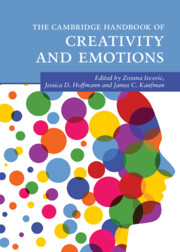Book contents
- The Cambridge Handbook of Creativity and Emotions
- Cambridge Handbooks in Psychology
- The Cambridge Handbook of Creativity and Emotions
- Copyright page
- Dedications
- Contents
- Figures
- Tables
- Contributors
- Acknowledgments
- Creativity and Emotions
- Part I Methods in the Study of Creativity and Emotions
- Part II The Development of Creativity
- 5 Affective States and Creativity
- 6 The Neuroscience of Creativity and Emotions
- 7 Attention, Affect, and Creativity, from Mindfulness to Mind-Wandering
- 8 Motivations, Emotions, and Creativity
- 9 Managing Difference and Uncertainty and Creativity
- 10 Creativity and Emotional Intelligence
- 11 Emotions across the Creative Process and across Domains of Creativity
- Part III Emotions and the Creative Person
- Part IV Emotions and Creative Products
- Part V Emotions and Creativity at School and Work
- Index
- References
10 - Creativity and Emotional Intelligence
A Complementary Pairing
from Part II - The Development of Creativity
Published online by Cambridge University Press: 16 February 2023
- The Cambridge Handbook of Creativity and Emotions
- Cambridge Handbooks in Psychology
- The Cambridge Handbook of Creativity and Emotions
- Copyright page
- Dedications
- Contents
- Figures
- Tables
- Contributors
- Acknowledgments
- Creativity and Emotions
- Part I Methods in the Study of Creativity and Emotions
- Part II The Development of Creativity
- 5 Affective States and Creativity
- 6 The Neuroscience of Creativity and Emotions
- 7 Attention, Affect, and Creativity, from Mindfulness to Mind-Wandering
- 8 Motivations, Emotions, and Creativity
- 9 Managing Difference and Uncertainty and Creativity
- 10 Creativity and Emotional Intelligence
- 11 Emotions across the Creative Process and across Domains of Creativity
- Part III Emotions and the Creative Person
- Part IV Emotions and Creative Products
- Part V Emotions and Creativity at School and Work
- Index
- References
Summary
Emotions are part of the creative process, and emerging research shows the emotions and creativity association extends well beyond simply the enhancing effects of pleasant emotions in laboratory studies on divergent thinking. More and more, researchers are recognizing that how the creator interprets, channels, and manages their emotions matters. So, are emotionally intelligent people more creative? The short answer is, it depends on who you ask. In this chapter, we will first describe prominent models of emotional intelligence (EI) and creativity and then review what evidence exists for the connection between the two constructs. We next describe our own conceptualization of EI and creative achievement grounded in the ability model of EI and actual creative performance. We conclude with examples of training programs and educational initiatives that can support both the development of EI and creative abilities.
- Type
- Chapter
- Information
- The Cambridge Handbook of Creativity and Emotions , pp. 186 - 204Publisher: Cambridge University PressPrint publication year: 2023

